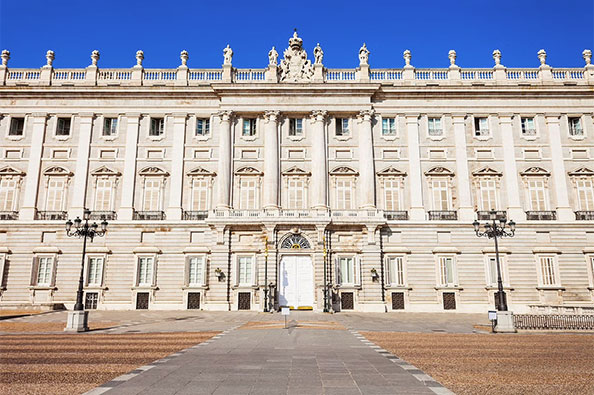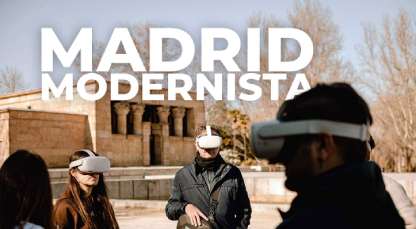Walking Tour and Royal Palace of Madrid Semi Private with Skip the Line Tickets
- 4.6 / 5 641 reviews
- 2 hours
- Easy
Semi-private guided walking tour and skip-the-line entrance to the Royal Palace of Madrid.
16 passengers maximum for this semi-private visit to the Royal Palace.
We will start our visit from Calle Mayor 43, to get to know the Plaza Mayor, Calle del Codo, Plaza de la Villa and finally reach the Royal Palace through Calle Bailén.
Click here to embark on your virtual journey: Tours Videos
Duration
Language
Rewiews
Included
Guided Tour from Calle Mayor, 43
Official mono lingual Guide
Skip the line access to Royal Palace
Visit with Radio Guide and gift headphones.
Excluded
Gratuities
What do I need to bring?
Sunscreen
Cap or hat
Please note
Wheelchair accessible
Not suitable for pets
Our guide will be waiting for you at the door of Fun and Tickets Main Office, Mayor 43 Street, 10 minutes before the start of the Tour.
Although the entrance to the Royal Palace is always reserved for our clients, sometimes the access control may be blocked due to the capacity and security controls, being the entrance delayed a few minutes for reasons beyond the control of this operator.
Cancellation Policy
Free! Free cancellation up to 24 hours before the activity starts. If you cancel under this time or do not show up, you will not be refunded.
When to book?
Cut off: 1 hour before the start of the activity
Fun and Tickets Main Office
Calle Mayor 43, 28012 Madrid.
Welcome to our meeting point located at Calle Mayor 43. From here you will begin your visit to the Royal Palace in a maximum group of 8 passengers.
Plaza Mayor
The name of the square has changed over time. It has been known as Plaza del Arrabal, Plaza de la Constitución, Plaza Real, Plaza de la República and now Plaza Mayor. These names reflect events, histories and reigns in Spanish history.
“Plaza del Arrabal” was the original name of the current “Plaza Mayor”. The Plaza del Arrabal was the most popular market place until the end of the 15th century. After the Constitution of 1812, all the main squares in Spain were renamed “Plaza de la Constitución”. It kept this name from 1820 to 1823, from 1833 to 1835, from 1840 to 1843 and from 1876 to 1922. When the King of Borbón was restored in 1814, it was known as the Plaza Real. In 1873 the name was changed to Plaza de la República. At the end of the Spanish Civil War it was given its current name, Plaza Mayor.
Mercado de San Miguel
Plaza de San Miguel s/n, 28005 Madrid.
More than 100 years have passed since the Mercado de San Miguel opened its doors as a wholesale food market. Today, this historic building is one of the most important gastronomic markets in the world. It allows visitors to experience the essence and main flavours of every corner of Spain.
From the finest Iberian ham and the freshest fish and seafood brought in daily from Galicia, to Mediterranean rice dishes and the most exquisite cheeses from Castile, Asturias and the Basque Country, you’ll find all the highlights of Spanish cuisine at the Mercado de San Miguel. Spread over more than 20 stalls, the common denominator is a commitment to quality tapas and pub food.
Calle del Codo
Calle del Codo, 28005 Madrid.
This small street is one of the two most charming squares in Madrid: Conde de Miranda and Villa. And it can boast a space protected by the historical and artistic environment that surrounds it: on the corner of the Plaza de la Villa stands the Torre de los Lujanes (15th century). In the same part of the street you will also find the Royal Maritense Economic Society of Friends of the Country, the old Municipal Newspaper Library and the Church of Corpus Christi, where the convent of Las Carboneras is located, since the congregation keeps an image of the Immaculate Conception found in a charcoal kiln, to which various miracles are attributed.
Plaza de la Villa
It was one of the main medieval centres of Madrid, as three streets start from it, according to the original layout of the city: Codo, Cordón and Madrid. On its outskirts are the main façades of three buildings of great historical and artistic value, built in different centuries. The oldest is the Casa y Torre de los Lujanes (15th century), in Gothic-Mudejar style, located on the east side of the square. It is now the seat of the Academy of Moral and Political Sciences.
Royal Palace Madrid
Calle de Bailén s/n, 28071 Madrid.
The Royal Palace of Madrid is the official residence of the King of Spain; however, the current kings do not live there, but in the Zarzuela Palace, so it is used for state ceremonies and solemn acts. This is where our visit really begins.
Although Juvarra’s original project was never completed, the Royal Palace of Madrid can boast of being the largest inhabited palace in Europe. And we say inhabited because, although the Spanish royal family does not live there, it is the place where they have their official residence. As we have already mentioned, the building, whose construction lasted until 1764, when Carlos III first lived there, covers 135,000 square metres and has 3,418 rooms, not to mention 870 windows, 240 balconies and 44 staircases. The comparisons are uncomfortable, but despite what many believe, the Palace of Versailles, near Paris, has 67,000 square metres, so the one in Madrid surpasses it.
In the tourist visit, the almost 3,500 rooms are not covered, but some of the most outstanding rooms, around twenty, are. Walking around the interior of the Royal Palace is like travelling back in time to the golden age of the Spanish court in the 18th and 19th centuries. One of the most impressive moments is the encounter with the Throne Room, the true symbol of the power of the Crown. The two thrones defended by the golden lions saved from the destruction of the Real Alcázar, the rich tapestries, curtains and carpets, the luxurious mirrors and lamps.
Fun and Tickets Main Office
Calle Mayor 43
Madrid








